The eurasian mountain dogs
- and a clarification of the legends about the " large Dog of Tibet "
|
|
The eurasian high
mountain landscape from the Atlantic to the south Chinese sea developed -
like the American Kordillen - before 130 million to 500,000 year during
so-called alpid folding. These mountains are thus the youngest mountains of
the world, not yet sanded off of wind and weather of world history, high and
rugged, with summits, which rise up the far over timber line inside in the
eternal ice.
The Alpid folding chain in Eurasia extends
from Western Europe until Eastern Asia. It pulls from the Pyreneeses over
the alps and in the northern elbow over the Karpaten, the Caucasus and the
Elbus mountains to the Hindukusch. The southern elbow leads across the alps
across the Balkans, the Ponti mountains and the Taurus mountains to the
Zagros mountains and across Pamir and the high country of Afghanistan
likewise up to the Hindukusch. From there three mountain chains continue to
pull to the east. The most impressing is the southern chain of the Himalaya,
which drags on over behind India into the Southeast Asiatic island world.
The northern chain, the Tien-schan mountains, makes the connection to the
age-old mountain landscapes of Southsibiria, to the Altai, to the Kentej
mountains. The middle chain covers the entire highland of Tibet.
Kailasch, aus der Hochebene gesehen
Mount Kailash, seen from the tableland |
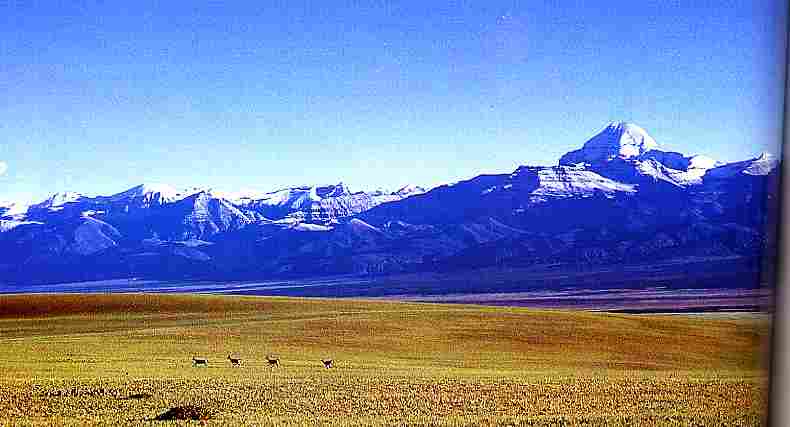 |
In the lee of the mountains, where the
clouds do not rain any longer, have themselves far dry regions developed:
the grass steppes in Kazakhstan, in the Ukraine, in Anatolian and the
drying-savannes of the Mediterranean area. And enormous, life-hostile half
and sand deserts developed: the Kara Kum and Kisil Kum in south Russia, the
large salt desert and the desert Wu Lut in Iran, the Tarim basin and the
desert Gobi in China and that Mongolia.
The entire eurasian high mountain
landscape is a landscape of the most glaring contrasts: There are deserts
and moisten wet forests, high mountain pastures and subtropical hard leaves
wood. There are areas with eternal spring, eternal high summer, eternal
winter. There are areas, there is it times high summers, times ice winters.
And the daytime temperatures vary frequently between +30 °C over noon and 0
°C at the night.
No miracle thus that the high mountain
landscape was only thinly settled. The high mountains with its stored
deserts and steppes are not paradies scenery, in which humans settle gladly.
It was therefore used frequently only as place of refuge of pressed peoples,
who there - in large, natural fortresses - which survived time runs and the
wars by the more valuable settlement country. No miracle thus also that the
population of this elongated high mountain strip is just as mixed as in
completely Eurasia: At the north slopes and in the adjacent wintery cold
drying steppes we find the most diverse so-called Turkpeople, which
developed in the large people migration times from mixtures of europide and
mongolide trunks: the Hungary, Turk, act arene, Kirgisians, Kasachen,
Usbeken, Turkmenen, Uiguren. In the west and southwest the " white "
Europoide settles: the Europeans, Kurdians, Iranians, Afghanen, Tadschiken,
Pakistanians, Indians. And in the east up to the Hindukusch the " yellow "
Mongoloidian lives ": the Tibetians, the Mongols, Burjaegen, Chinese and the
Khmer.
In the entire area of the eurasian high
mountain strip we find today thus a multicolored mixture of the most diverse
peoples. Each people has its own history, language and culture, its own
traded survival strategies. Cattle breeders and hirten remained them however
to the majority. They live, depending upon climate and altitude, on the
breed of sheep, goats, horses, camels or Yaks. The agriculture plays in the
mountains and in the drying steppes to today only a supporting part.
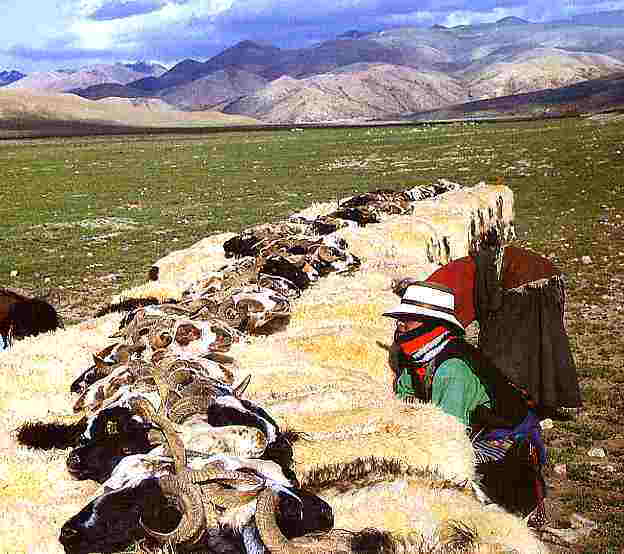 |
Tibetische Nomaden beim Melken der
Schafe
Tibetan nomads when milking that sheep |
Humans and cultures in the high country
and in the mountains also are so different, dog owners are them all. And
their dogs are among themselves - from the Pyreneeses in the Tibetan high
country - everything rather similar: |
|
There is well boned and deliberate medium
sized to very large dogs. But they are cross-country like chamois and also
so undemanding in attitude and care. They are more or less shaggy haired,
provided with a natural coat-tank all. They have short triangular hanging
ears and very communicative bushy tails, which roll them in excitation
highly over the backs. They are black or white, red-brown, grey or golden or
everything together. From a character they are lively, independent and
compatible, but provide with a substantial pig-headed and a certain natural
sharpness. All show still much original behavior and no fear of powerful
opponents, of large cats, wolves, bears. These characteristics were it
probably, on which their relationship with humans developed itself.
Everywhere of the Pyreneeses until Tibet meet we it as protection and awake
dogs of the residents hirten and cattle breeders. And it is not to be
accepted reliably exaggerated that only with the help of this strengthen a
surviving of humans in these " wild " areas, self-willed dog in the long
term was possible
Blue & tan - coloured Do Khyi -a
nomad-
and mountaindog
source:, Kynos Atlas, Kynos publishing house |
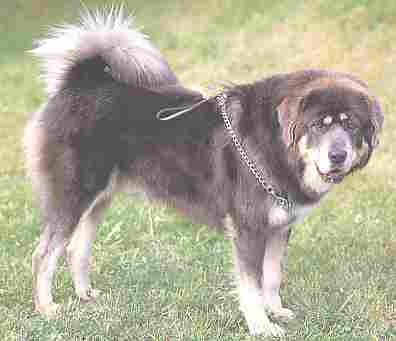 |
One aimed breed never operated the hirten.
Until today each area has its " regional race ", which differs from
other areas: The colder the climate, the more largely the natural predacious
animals, the more longhaired, more largely the dogs are. Also the
old-established dogs from the high mountain belt were subject to the "
natural selection " and had to get along with the climate and their with
competitor.
From where now these " original " dogs
came and among them ranks which modern races, about it one argues, since it
cynologists (= dog researcher) gives oneself. Were the first " mountain dogs
" - as we want to call them here once completely carefully and all
controversy avoiding - particularly for the wolf defense bred " shepherd
dogs "? Or were they carriage dogs, which along-brought humans from the
north and whom in the mountains all carriage dog characteristics lost? Was
the first mountain dog the Albanian " white " Molosser? Or do they all of
the black large dog of Tibet (= Do Khyi) descend?
From to today as dogs recognized early and
to before-historical bone finds no answer can be derived. As the oldest
finds those, which one found in Roman soldier camps, are considered to a "
large wolf-similar (!) dog race of the antiquityt ". One found these dogs
always at the rear loss gate, porta decimana and gave in such a way its
discoverer to these dogs to the name " camp dog ". Large dogs of " mountain
dogs ", which are older than the Roman camp dogs are until today officially
do not admit become. If one may trust the excavators and their zoo-logical
advisors, it gave up to the Roman time (approx. 300 v.u.Z. - 300 n. and Z.)
world-wide only small dogs and large wolves.
But one may doubt such statements confidently:
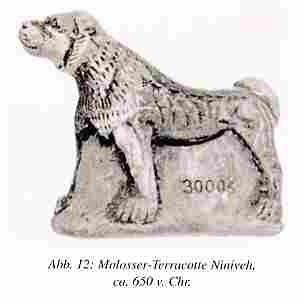
Niniveh loam-figure 650 B.C. |
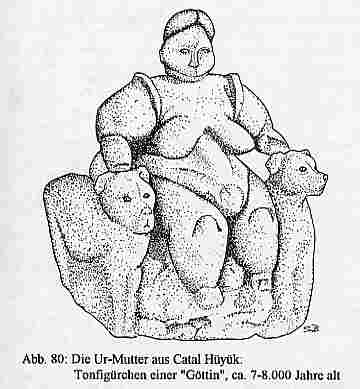 |
In the approx. 8500 years old Jarmo in the
Iraq one found small Terracotta: shaggy dogs with short, broad lip, with
pendulous ear and highly curled-up tail, in which one can recognize easily
small, primitive images of longhaired mountain dogs. And in the 8000 years
old south Turkish Catal Hueyuek one excavated the Statuette of a mother
divinity: It sits on a throne and beside it, on the right of and left, sits
- in typical guard float - two enormous dogs, like bears - no wolves. The
Sumerer (2800 - 2360 B.C.) designated in their cuneiform script the lion
with the word " large dog " (we think note
Author, once of the Tibetan term of " lion dogs"). And that is a reference
to it, " that the dog an animal of approximately similar size " - or
imposive strength -, available for comparing " must have been ", as Strebel
(1904/05) means.
In Ninive (704 - 612 B.C.) and Babylon (1700-539 B.C.) between Euphrates and
Tigris one found small tone pictures, in which strengthened, shaggy mountain
dogs is explained. They belonged to ritual disease driving. The represented
dogs are far more finely representative than the dogs of Jarmo (s.o.), but
it are just as similar to them as modern flock guardian.
|
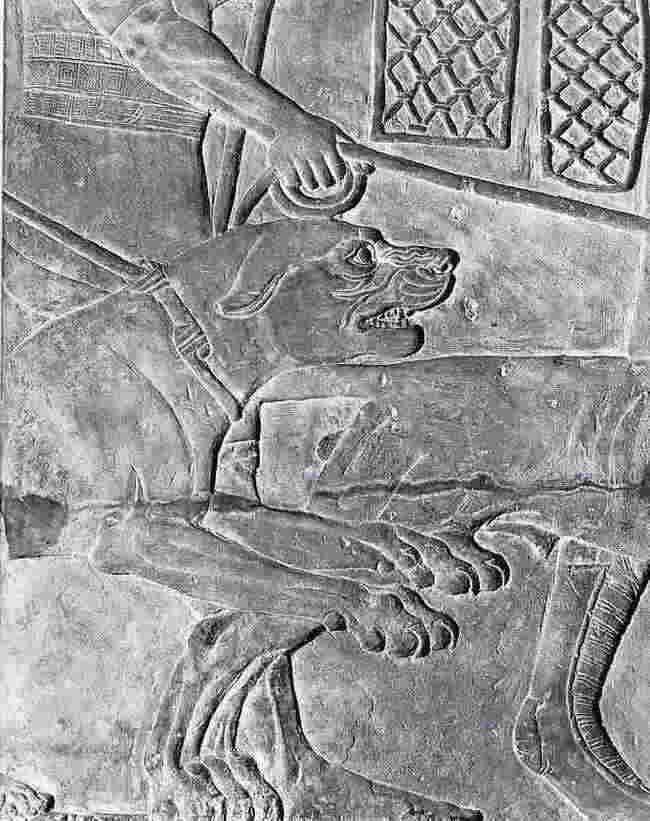 |
Assyrian wall-relief Palace v.
Ashurbanipul
700 B.C. -heavy Hunt-/ Staghounds |
In Ninive and in Babylon we find then however also beside the old, shaggy
for the first time shorthaired mountain dogs, which one probably as hunt
combat or War dogs and from those the ancestors of our modern Great
Dane, Boxer, Mastiffs, Rottweiler bred surely developed.
Assyrian Relief 640 B.C.
shorthaired War Dog- or Hunting Dog |
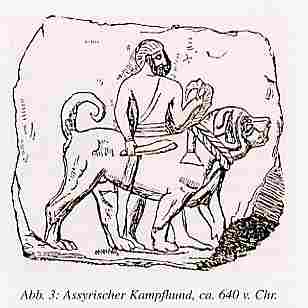 |
|
|
The first written reference to a large
mountain dog originates however from China: In the year 1121 B.C. the
people of the Liu is to have given a dog to the " large tread of the kingdom
", that was 4 foot highly (= approx. 47 inches !).
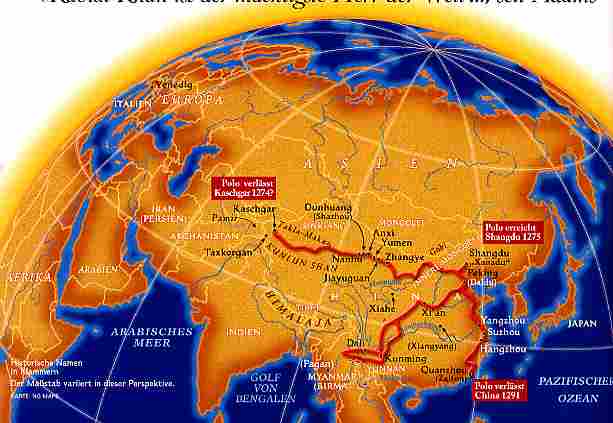 |
Route from Marco Polo 1273 to 1290
A.C.
he went around the high plateau of Tibet and the Transhimalya, Tibet
even never seen.....
Whether its description of the Tibet "dogge" originates from " hearing
legends " from narrations of the Mongols and the Chinese ?
some of its descriptions are seen today of scientists as rendition of
legends from the natives...
source:National Geographic 6/2001
|
Marco Polo, globe-trotter made of Venice
(1254-1324), reported on it and says even: " the people of the Tibetans is a
badly constituted race, it holds dogs, as largely as donkeys, which are
excellent for the hunt of savages animals, in particular the wild oxen (Yaks).
Marco Polo exaggerated surely. With approx.. 25/26 inches hight at shoulders
is the Tibetdog not (DO Khyi) a giant under the mountain dogs, even if their
approx. 133 pounds (note: male) already impression make. It spread here
simply only the first rumor, which climbs around the mountain dogs and which
says:
- the mountain dogs are terrible,
dangerous giants
The second rumor says:
- The mountain dog is a " griffin "
ein Greif ?
oder die Entmystifizierte Zeichnung eines
Greifes - eine der wohl besten bildlichen Darstellungen
des 18. Jahrhundert
A griffin ? or the de-mystification design on a
griffin - one of the probably best figurative representations 18.
century |
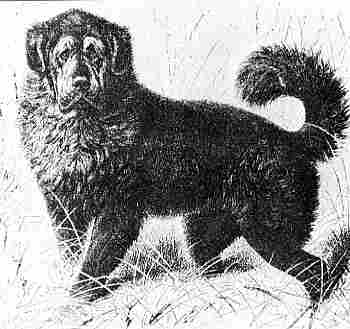 |
405 vB.C. an age-old frontasiatic legend
described and said Ktesias, Greek historian and physician at the Persian
yard as secured knowledge: In the high mountains live so-called " griffin ".
They are large winged dogs, like wolves (note: Grey wolf height at shoulder
of 27 - 31 inches), with claws such as lions, and at the whole body covers
with black feathers, which are red-yellow colored only at the chest (note:
probably black & tan color in the shaggy-hair). Due to the watchfulness of
these animals it falls heavily to mount these mountains. From the furious
mountain guard giants thus magic eagle lions became with the time. And thus
the reason was put to the third rumor, that already meant:
- The mountain dog is a tiger
half-breed
This rumor comes from Aristoteles (384-322
B.C.), which knew the dogs only of hearing legends. Aelian (170-235 B.C.)
then the following copied of it:
|
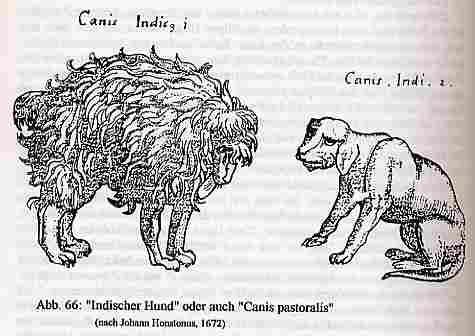 |
Canis Indica,Canis pastoralis, Indian
Dogs after
Johann Honstonus, 1672 A.C. |
Those sucked. " are bound Indian dog ",
the Tibetans, by their gentlemen to trees and left alone. " pushing now
tigers on these dogs and they are hungry straight, then they tear the dogs
up. If they come however satisfied, then they leave themselves with the dogs.........
The next brood however of this tiger and a
dog follows the mother... and becomes a dog. Such dogs now, which may praise
themselves the birth of a tiger, defame it the deer to hunt or with a pig
tie up. The lion however they result and give thereby their earlier birth to
recognize " and then follow the long-known, sadism, bloody history of a dog
a lion " choked " and also not released than one it successively tail, all
four legs and the head finally disjointed.
The fourth rumor is less bloody, it
announces:
- The mountain dogs are dragons.
Columnella (approx. 50 A.D.), Roman Agrarien of the emperor era, writes: "
as guardians of the yard one must select a large, powerful dog, which has a
loud and deep voice, so that it already strikes his sight the malefactor by
its bark and into the escape. It is to be in-colored white, if it at the
herd, black, if it becomes related in the yard... The head is so powerfully
that it appears as the largest part of the body, the ears is folded down and
will overhang in front, the eyes is stinging black or grey-iridescent and;
the chest is broad and shaggy, the front spar and strongly... such calls the
Greeks Dragoi, dragons ". About breed and attitude of these " dragons "
nothing is said. It means only, one is to buy it with the hirten, and one is
to crop them 14 days after the birth the tail.
Field- orStaghound
Germanic Bear Dog |
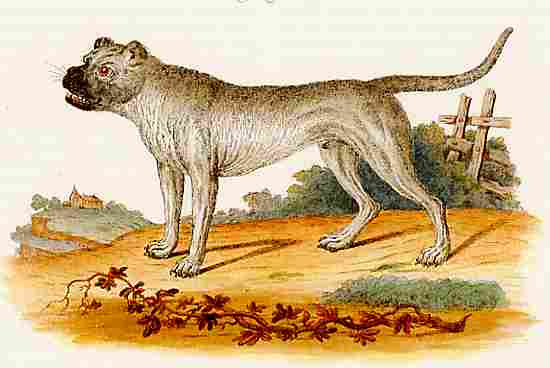 |
|
|
Over breed and attitude stands then
however somewhat in the old-Persian Avesta, which for holy books of the
Parsen, which were only laid down in writing before 1500 years, however with
security likewise are enough for those, if not longer, verbal excessive
quantity precedes: ", " the dog " says the creator to its prophet
Zarathustra, " let I be garb and his own footwear own naturally have; I made
it eagerly are awake, sharp-biting, get its food of the men, thus he pay
attention on the messuages " wolf dog of half-breeds however, then it is
called further, must be killed. " on the side dogs are thrown: deadly as it
were for house and yard; and now become more harmful and perishable and for
house and yard more dangerously than otherwise the dog it is, on the other
side wolves is thrown: deadly for house and yard, and those become more
harmful and perishable and for house and yard than otherwise wolves are more
dangerous." One sees, humans obviously already very early negative
experiences with wolf a crossings made and to have such " hybrides " rather
killed. The fifth rumor, which means:
- All mountain dogs, flock guard,
are " wolfblood shepherd dogs "
One may refer that confidently in the
realm of the fables - just how as all other rumors specified above also.
What now however real are the mountain
dogs and as lived and live them?
Over it there are, although meager reports:
In old Germanic
" wisedom " these dogs of " sheep dogs ", " sheephound ",
" Fieldhound ", " Indian dogs " or " Hirtenhound " are called. " sheep dogs
" (Russian Owtscharka) are however no shepherd dogs. They guard not on
arrangement and go-eat the shepherd. They are awake only, independently and
without instructions. They do not take sheep, cows, Yaks anywhere, them
remain in their proximity " changing " along and fit up. They are the dogs,
" those the wolf bite, to it the cattle from the muzzle take and on the
shouting, which is raised from the land people with the appearance of the
wolf, immediately hurry on far distance to assistance.
In this country belonged these dogs to the
standard equipment of the moving hirten and the established farmer on the
lonely yard. With the disappearing of the wolves and bears, with the fall of
the free hirten and the farmers, with the penetration of the princely power
monopoly in the absolutism, these guards of personal liberties disappeared
more and more. Their role at the herds took over the lighter, tractabler
shepherd dogs and on the yards the smaller " farm dog " and " ratting
pintcher ".
|
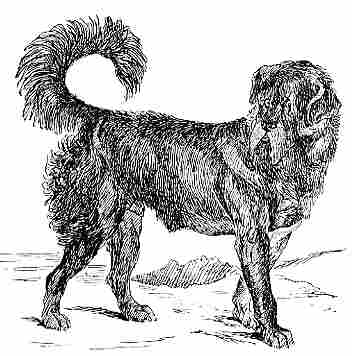 |
Tibetan dog, design after William
Youatt,
in the year 1850. |
But in other countries they and their
functions remained. The English world traveler Youatt reports 1845: " the
dog is bred on the plateau of the Tibet limiting Himalayamountains. " the
men come down at different seasons into the valleys, in order to sell
boraxes Moschus and such. The women remain at home, and they and their herds
must be defended sometimes energetically by these dogs. They are the
protector of nearly each larger rural possession."
Samuel Turner describes its experiences
with the Tibetan dogs around 1800: It " met a heap of tatarian hirten, who
always live in tents and to do nothing, when to feast... in one of the
miserable villages I painted its cattle out of curiosity between the houses
around, and there I found everything calm, I went into a stony verge... as I
occurred, jumped up to my astonishment a large dog, which came if its
courage equal its size, enough were strong to fence with a lion. It held
back me with its raving barking at the gate, and I was frightened very much
at the beginning, since I remembered and knew however the cowardice (!) of
the dogs that they are courageous only if they notice that one is afraid of
them, stood I quietly....
The Hungarian count Bela Szechenyi in
Tibet made similar experiences:
" on a Exkursion in a valley I saw against
evening a light and heard dogs barking.... hardly was I unite one hundred
step forward gone, there surrounded me suddenly five Tibetan dogs. I
believed my last instant come..."
One sees like the rumors over the enormous, tiger-same dragon-seizes with
wolf blood probably developed. Count Szechenyi did not let itself be
discouraged nevertheless. He bought three of this " Beasts " and wanted her
to Europe to introduce. It had however no large success thereby.
|
|
And like its dogs, then it also all other
imported Tibet-Mastiff was issued: They died again and again early - at
wrong attitude and too much wet-cold weather. Or they landed behind lattice
bars in zoo-logical gardens. The Europeans had forgotten obviously handling
these independent, resistanceful dogs.
That however these dogs are not " dragons
" and that one can come with them also as stranger by right, other
globetrotter describes that. Schlatter e.g. reports to an only medium sized,
but nevertheless quite penetrationable local race of the nogaian dogs at the
Asow sea. It recommends the following:
- One carries oneself a Nomad
forward in the national costume as a companion That gets along with the dogs
and with it the dogs, too
- One goes as stranger, slowly
and holds a long stick behind itself. The dogs usually pack from the rear
and bite then into the stick.
- One probably does, if one
throws something meal to them, with which they are occupied until one
reached a house
- One may never strike it,
otherwise all dogs of the village meet on the howling of the met dog, and
the thing becomes more serious than before.
- One puts oneself simply.
Sitting humans... excited only its curiosity. They formed a circle around it,
watched it surprised and ran then without excitation apart.
We see: the " dragons " are completely
gentle, if one treats them gently. They answer only - to aggression with
aggression, to indifference with indifference, to friendship with calm
tolerance. One can find such " gentle dragons ", which guard only their
messuage, today as holiday-makers in the eurasian high mountain strip still
everywhere.
We ourselves met in such a way one in the
Pyreneeses: It had surely no internationally recognized geneological table,
and each breeder would have segregated him as " mismarked ". But it was a
Pyrenees mountain dog, as it surely already for thousands of years gives. It
guarded the camping site, the hotel and its " patronne " with calm attention.
He picked up with nobody, bore even strange dog and was all day long
kilometres away on the way, from prospect place to prospect place, in order
to control its realm. It however never lost sight of its patronne thereby.
If one had to talk something over with it, then he - as grown from the soil
- was, completely calmly, completely suddenly there gently. But unmistakably.
Large Swiss mountain dog are to have set up a rule, which says: " it is to
be danced forbidden with the Alpine dairymaid " The mountain dog in the
Pyreneeses seemed to have something similar in the head
In this function - as independent guards
and protectors - we today still find the mountain dogs in the Pyreneeses, in
the alps, in the Tatra, in the Caucasus, in Anatolien, Kurdistan and Tibet.
Everywhere they are held as awake and protection dogs. And thus they this
job also well fulfill, them are supplied properly. Already in the
old-Persian Avesta a caring is set up: " one get out milk and fat including
meat, one it the dog as meal bring, then is its due meal." And " again a
well feasible act " is not it, these dogs to give " not reduced bones or to
hot meals ". Because " if the bones it between the teeth to put remain
settling or in the neck, or if it to hot meals the muzzle or tongue burns,
then the perpetrator become thereby incurred the loss body."
The Roman poet Vergil writes in his
Hirtenpoem:
" over everything do not forget to
me the care of the sheepdogs.
Feed with wheys and bread. If those
guard your stables,
You are afraid neither the wolf nor
nocturnal curving thieves,
Still the bold assault of iberian
robbers." |
| Tibetan nomads with the "shearing"means
comb out of sheepwool. |
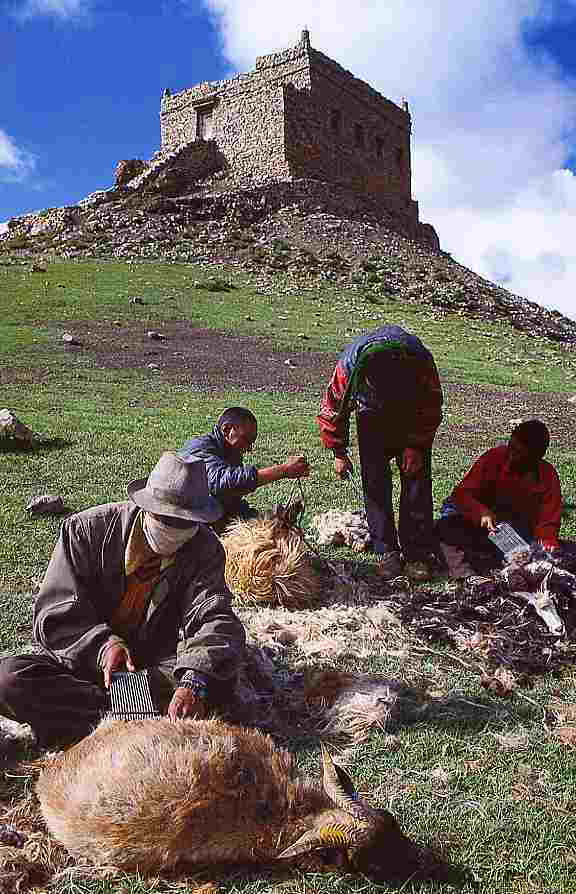 |
And also the dogs of the rather poor hirten in Tibet are well fed according
to reports - with flat cake, corn flour and goat or sheep milk.
|
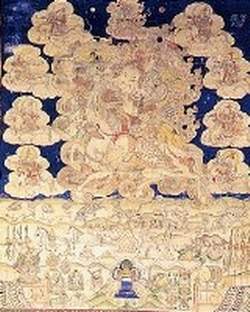 |
Thanka representation hero King Gesar of Ling
" the Kings of Tibet"
Trailer representation cattle of the nomads and
predatores under the protection of the Do Khyi. |
Goods with the Dingos, Parias the well
held, well nourished dogs the exception, then it seems to have turned around
with the mountain dogs exactly: Nearly everywhere the mountain dogs are
probably supplied and maintained. This fact and the respected guard position
of the dogs, which stand in the clear contrast to the otherwise usual role
of the four-legged nameless " garbage disposal ", relationship between
humans and dogs appears at first sight as not straight " primitve ". Here
such a thing seems to be present like a contract with contents: You watches
out for my things and defends her, and I give you for it your food and my
confidence. But as the present treaty, seen from the dog he also looks as
again fashionable does not have to be not so absolutely again fashionable.
One cannot coin/shape dogs like grey geese, it learn and forget their life
long, like all modern animals. But young mountain dogs (and their modern
descendants, the hirten -, alpin herds-, cattle dogs and mastiff-like dogs)
become acquainted with usually in the first four life months " it " herds
completely personally. And they differentiate then " it " herds from all
different: They love " their " cat and hunt the others, them love " their "
people and are strangers opposite distrustfully to rejecting. This
characteristic - " good-naturedly against its fellow tenants ", but "
against foreigner rejecting " that is own all to still ancient mountain dogs
until today. Humans say this characteristic to them after, since they know
mountain dogs, and humans at their mountain dogs have this characteristic
always estimated. |
|
Inferred out: " from upright humans to the
dog owner" 500,000 years Ko-evolution and culture history of humans and dog
Authors: Gudrun Beckmann & Susanne
Beckmann ", with friendly permission of Mrs. Gudrun Beckmann and the TG
publishing house Ulrike Beuing GmbH, 35392 pouring.
ISBN 3-929301-02-4
Ruth Reheuser 04/2001 |
|
|
|
|
|
|

|
![]()













